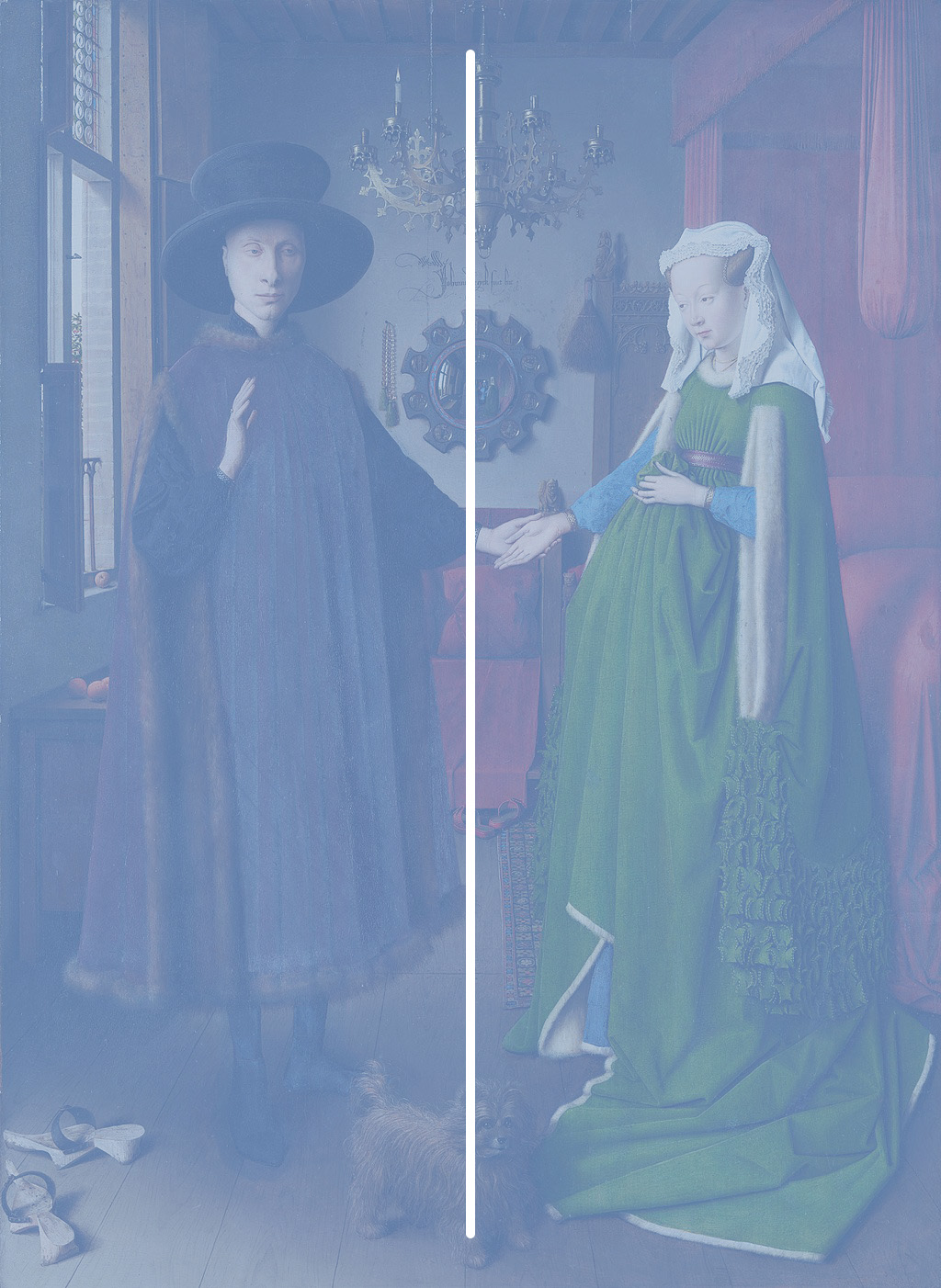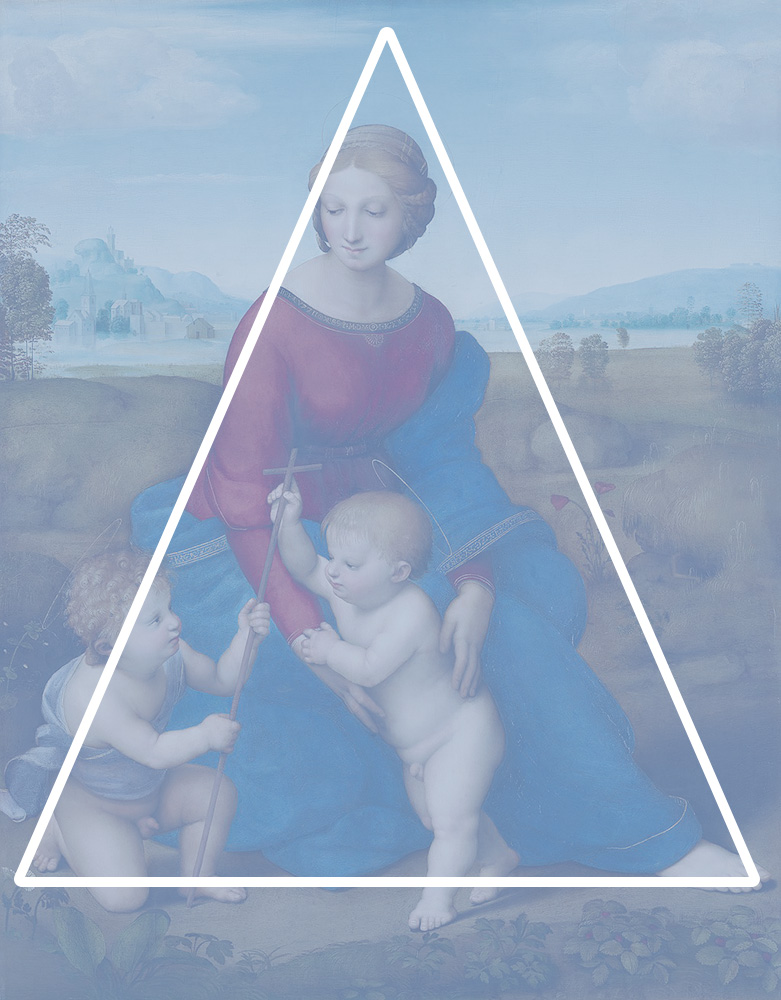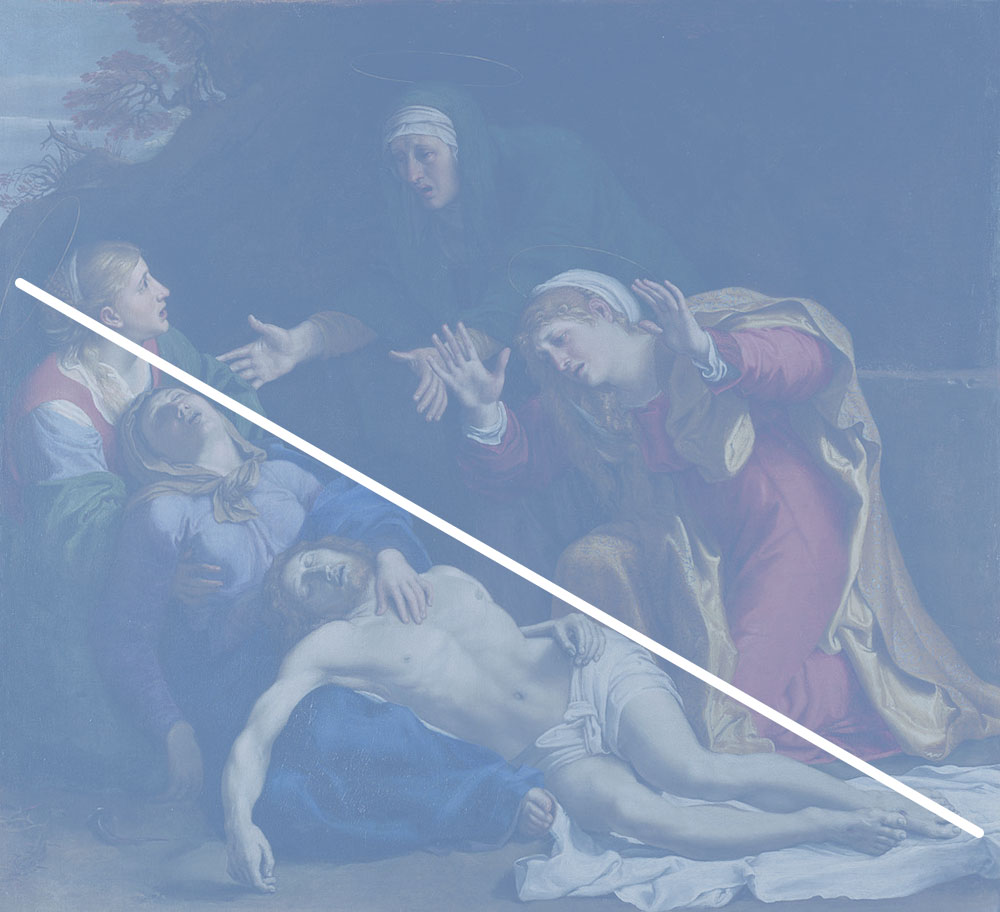Composition plays a central role in art and significantly influences the impact and aesthetics of a work of art. It is the secret behind a harmonious balance that captivates the viewer’s eye and evokes a profound emotional response.
The goal of this article is to provide artists and hobbyists with techniques to create harmonious balance in their artworks. We will explore the basics of composition and find out how to use these insights for our own artworks.
Different Types of Composition
Compositions can be divided into different types, which differ in the organization of space. This affects the respective image structure, which we perceive as dynamic or static depending on the composition.
Symmetrical Composition
Symmetrical composition is one of the simplest forms of organization in art. It is based on the simple idea of mirroring elements along an invisible vertical axis.
In a rectangular format, the image is divided into two identical halves by this axis, with elements of the same size and shape arranged on both sides. This creates a visual balance and a harmonious equilibrium in the artwork.
Symmetrical composition offers a clear and orderly structure that allows the viewer easy readability. Perfect symmetry creates visual stability and can have a calming effect. The repeated shapes and patterns create a certain predictability and convey a sense of familiarity.

Jan van Eyck, Public domain, via Wikimedia Commons

Example of a symmetrical composition
However, the strictly balanced arrangement of elements can sometimes make the artwork appear too static and even boring. The lack of variety and surprise can reduce the viewer’s attention and decrease visual tension. The monotony of symmetrical composition can make the artwork appear less exciting or dynamic than other forms of composition.
To make symmetry more interesting and break its monotony, artists can introduce subtle variations or asymmetrical elements. By slightly varying the placement of objects, adding different colors or textures, or incorporating unexpected details, they can disrupt the balance of symmetrical composition and create visual interest.
Asymmetrical Composition
Asymmetrical composition (also known as dynamic balance) is an exciting and dynamic approach to creating artworks. Unlike symmetrical composition, where elements are mirror-imaged along a central axis, asymmetrical composition is characterized by a deliberate imbalance and a non-mirrored order, with the focal point shifted to the side.

Thomas Gainsborough, Public domain, via Wikimedia Commons

Example of an asymmetrical composition
An asymmetrical composition creates tension and visual interest, inviting the viewer to look more closely at the artwork and explore the various elements. By deliberately placing objects, shapes, lines, and colors at different positions in the image, a lively and energetic representation is created. Asymmetrical composition can convey a sense of movement, unpredictability, and imbalance, prompting the viewer to focus their attention on the artwork.

The original uploader was Frankipank at German Wikipedia., Public domain, via Wikimedia Commons

Example of an asymmetrical composition
Central Composition
In central composition, the central elements and motifs of the image are arranged in the middle of the image space. This arrangement forms a visual center that deliberately focuses the viewer’s attention on the middle. The center or visual center can also be shifted and does not have to be exactly in the middle of the image.
Central composition is often used to give a strong presence or importance to a specific motif. By placing the elements in the center of the image, they receive increased attention and emphasis. This allows artists to deliberately focus on a central theme or message.

Rembrandt, Public domain, via Wikimedia Commons

Example of a central composition with a diagonal base scheme
Although central composition is a powerful design element, one should also consider the challenges and possible disadvantages. An excessive concentration of elements in the middle of the image can create a static and balanced impression. There is a risk that the artwork may appear flat or uninteresting if there is no additional dynamism or variation in the arrangement and space.
Triangular Composition
Triangular composition was particularly popular during the Renaissance. It is based on the arrangement of elements in the shape of a triangle and was often used in paintings with Christian origins.
The triangle as a geometric shape has symbolic significance and often represents divinity, perfection, and spiritual harmony. In Christian art, triangular composition was frequently used to depict the relationship between God the Father, Jesus Christ, and the Holy Spirit (the Holy Trinity). The central element, typically a figure or object, is placed at the top of the triangle, while the other two elements are arranged at the sides. This arrangement creates visual stability and a harmonious flow.

Raphael, Public domain, via Wikimedia Commons

Example of a triangular composition
Although triangular composition originated in Christian art, it is also used in other contexts and genres of visual art. Artists use triangular composition to create a focused and harmonious representation. By consciously placing elements in the shape of a triangle, they can create visual tension and balance.
Diagonal Composition
Diagonal composition is based on the use of one or more diagonal lines and a corresponding division of the image space. In contrast to the perception of horizontal lines as lying down and vertical lines as standing up, the diagonal line brings strong dynamism and movement to an artwork. At the same time, the diagonal division of the image space can sometimes be perceived as an imbalance.
Diagonal composition creates a particular tension and energy in the artwork. The lines create visual movement that guides the viewer’s gaze through the image and conveys a sense of activity. The asymmetrical arrangement of elements along the diagonal reinforces this impression of movement and can create visual dynamism.

Annibale Carracci, Public domain, via Wikimedia Commons

Example of a diagonal composition
Diagonal composition is not only limited to diagonal lines but can also be applied to other elements such as objects, figures, or light. By positioning these elements along the diagonal, the artist can create an intriguing interplay of shapes and movements that enhances the overall dynamics of the artwork.
Elliptical Composition
Also popular in the Baroque period is elliptical composition. With the rise of astronomy and an improved understanding of our solar system, the elliptical form found its way into art to integrate the beauty and harmony of celestial bodies.
This arrangement creates an organic and flowing structure that conveys movement and dynamism. Elliptical composition can be used to evoke a sense of vastness, infinity, and harmony.

Paolo de Matteis, Public domain, via Wikimedia Commons

Example of an elliptical composition
Composition Sketch
A composition sketch is a sketch in which the compositional elements of the image being analyzed are represented in simplified form. As part of an image analysis, it can be used in various ways to understand, interpret, and evaluate the artwork.
Analysis of Image Structure
By sketching lines, shapes, and proportions, the relationships between the various elements and their spatial distribution in the artwork can be examined. This helps analyze and understand the image structure and how the composition affects the overall impression of the artwork.
Consideration of Balance and Symmetry
By capturing the placement of main motifs, the alignment of lines, or the distribution of colors and textures, it becomes clear how the composition contributes to visual harmony or creates tension. The sketch can provide insights into how the artist deliberately dealt with symmetrical or asymmetrical elements.
Focal Points and Visual Guidance
With the composition sketch, the focal points and visual guidance in the artwork can be analyzed. By sketching the placement of main motifs, lines, or contrasting elements, one can see where the viewer’s eye is directed and how the artist guides attention to certain areas. This clarifies the artist’s intention in shaping the visual flow of the artwork.
Interpretation of Emotional Impact
To interpret the emotional impact of an artwork, one analyzes the arrangement, perspective, contrasts, or color scheme of the image elements. The information processed in the composition sketch allows conclusions to be drawn about how the artist created a certain atmosphere through conscious compositional decisions.
Comparison and Contextualization
A composition sketch can be used to compare and contextualize the analyzed artwork with other works of an era or other works by the same artist. By comparing compositional decisions in different artworks, similarities, differences, or developmental trends can be identified. This enables a more comprehensive evaluation of the artwork within its artistic context.
Main image: Thomas Gainsborough, Public domain, via Wikimedia Commons